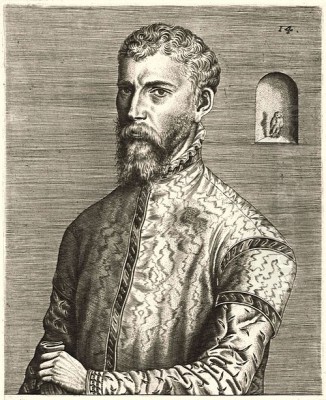
Herri met de Bles stands as a significant, albeit somewhat enigmatic, figure in the history of Northern Renaissance art. Active during the first half of the 16th century, he was a Flemish painter primarily celebrated for his contributions to the genre of landscape painting. Emerging from the artistic milieu of the Southern Netherlands, specifically the Meuse Valley region, Bles built upon the innovations of his predecessors to forge a distinct style characterized by panoramic vistas, fantastical rock formations, and the integration of narrative elements within expansive natural settings. His work marks a crucial step in the evolution of landscape as an independent genre in European art.
Life and Career: Fragments of a Biography
The precise details of Herri met de Bles's life remain scarce and subject to scholarly debate, contributing to the mystique surrounding the artist. Art historians generally place his activity in the early to mid-16th century. While some earlier accounts suggested a birth year around 1485, more recent scholarship often favors a birth date closer to 1510. His death is typically estimated to have occurred around 1550 or shortly thereafter. The lack of definitive documentation leaves these dates approximate.
His origins are traced to the Meuse Valley, with Bouvignes-sur-Meuse or nearby Dinant often cited as possible birthplaces. This region, known for its dramatic rocky landscapes, likely provided early inspiration for the distinctive geological features that dominate his paintings. His very name, "met de Bles," translates to "with the blaze" or "with the white forelock," possibly referring to a personal physical characteristic, though this remains speculative.
A pivotal moment in his career appears to have been his association with Antwerp, the bustling artistic and commercial hub of the Southern Netherlands. Records indicate that Herri met de Bles became a free master in Antwerp and joined the prestigious Guild of Saint Luke there in 1535. Membership in the guild signifies professional recognition and would have placed him within a network of fellow artists, patrons, and dealers. He is believed to have operated a workshop in Antwerp, likely employing assistants and possibly training pupils, such as Frans Mostaert.
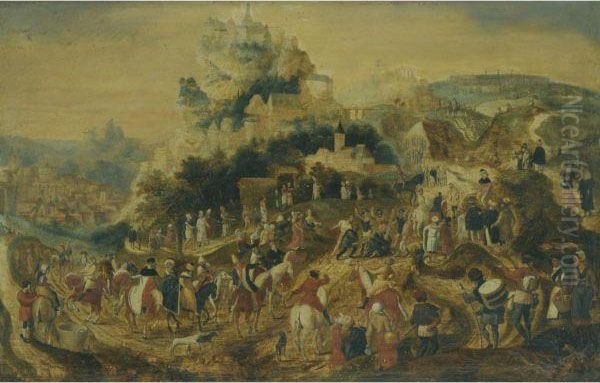
Evidence suggests that Bles spent considerable time in Italy, perhaps even making multiple journeys south. His distinctive style found particular favour among Italian collectors and connoisseurs. This extended stay, potentially including time in cities like Rome or Florence, exposed him to the developments of the Italian Renaissance, although his core style remained rooted in Northern traditions. His popularity in Italy is underscored by the nickname he acquired there: "Civetta." The circumstances surrounding his death are also uncertain, with one tradition suggesting he died in Ferrara while in the service of the Este court or local clergy.
Artistic Style: Crafting Imaginary Worlds
Herri met de Bles is most renowned as a landscape painter, working within the tradition often termed "Weltlandschaft" or "World Landscape," a genre pioneered by his influential predecessor, Joachim Patinir. Bles is frequently identified as Patinir's artistic successor, and some sources even suggest a familial relationship, possibly that Bles was Patinir's nephew. Whether by direct tutelage or profound influence, Bles clearly absorbed Patinir's approach, characterized by high viewpoints, panoramic vistas, and the use of distinct colour zones (typically brown foreground, green middle ground, blue background) to create a sense of atmospheric depth.
Bles, however, developed this foundation into something uniquely his own. He inherited Patinir's penchant for fantastical elements and strange, almost anthropomorphic rock formations, but often pushed these features further, creating landscapes that feel both observed and imagined. His compositions frequently employ strong diagonal elements, leading the viewer's eye deep into the scene, often past towering, craggy outcrops of rock that dominate the picture plane. These rocks are rendered with a particular vibrancy and detail that became a hallmark of his style.
His handling of colour is notable for its contrasts and atmospheric effects. While adhering to the basic three-colour scheme for depth, he employed rich hues and sometimes dramatic lighting to enhance the mood and narrative. There is evidence that Bles was aware of, and perhaps influenced by, Leonardo da Vinci's theories on aerial perspective, using subtle gradations of colour and a light atmospheric haze to suggest distance and unify the composition.
Unlike purely devotional art, Bles's works often integrate religious, mythological, or genre scenes into the vast landscape settings. The figures, while necessary for the narrative, are often small in scale, dwarfed by the grandeur of nature. The emphasis shifts from the specific religious ritual or mythological event towards the overall atmosphere and the emotional resonance evoked by the landscape itself. He masterfully blended the sacred and the secular, depicting biblical stories like the Flight into Egypt or Christ Carrying the Cross within settings that also included detailed observations of contemporary life.
Secular Interests and Detailed Observation
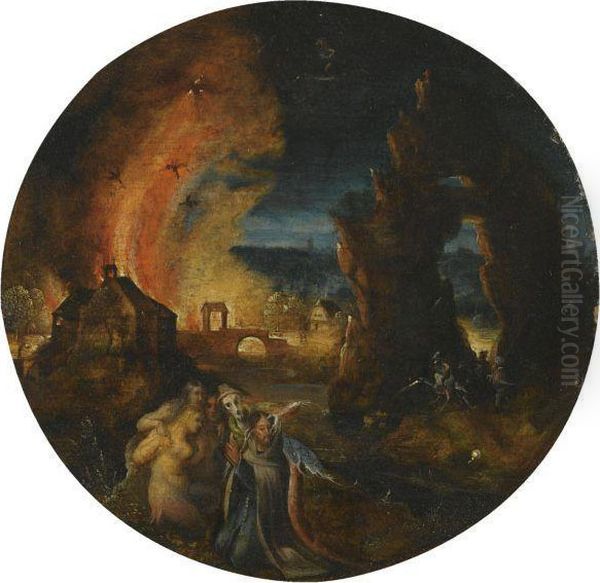
Beyond traditional religious and mythological themes, Herri met de Bles demonstrated a keen interest in depicting scenes of human industry and daily life, often integrated seamlessly into his landscapes. Particularly noteworthy is his recurring depiction of mining and metallurgical activities. Scenes featuring mine shafts, forges, and workers engaged in extracting or processing ore appear in several of his works.
These depictions are rendered with a surprising level of detail, suggesting careful observation and reflecting the economic importance of mining in the Meuse Valley region and elsewhere in 16th-century Europe. These elements add a layer of social commentary and realism to his otherwise fantastical landscapes, grounding them in the contemporary world. Similarly, he might include scenes of trade, agriculture, or travellers, adding narrative richness and demonstrating his broad range of interests beyond purely imaginative creation. This focus on secular activities within a grand natural setting anticipates later developments in genre painting.
The Signature Owl: "Civetta"
One of the most curious and identifying features associated with Herri met de Bles is his purported signature: a small owl often hidden within the details of his paintings, perhaps perched in the hollow of a tree or nestled amongst rocks. While not present on every attributed work, its frequent appearance led to his Italian nickname, "Civetta," meaning "little owl."
The precise meaning of this motif remains debated among art historians. It could be a simple visual signature, a rebus on his name (though the connection is unclear), or carry symbolic weight. Owls in Renaissance symbolism could represent wisdom, but also folly, darkness, or heresy. Given the sometimes unsettling or fantastical nature of his landscapes, the owl might have served as an ambiguous commentary or simply a personal emblem. Regardless of its intent, the "Civetta" mark became strongly associated with his work, particularly in Italy where his paintings were highly sought after by collectors.
Key Works: A Landscape Legacy
Although many of Herri met de Bles's works are unsigned and undated, a core group of paintings is confidently attributed to him or his workshop, showcasing the breadth of his style and subject matter.

Landscape with the Road to Calvary (also known as Christ Carrying the Cross): This subject was treated multiple times by Bles and his workshop. These paintings exemplify his ability to stage a dramatic religious narrative within an expansive, detailed landscape. The winding path, the crowds of figures, and the imposing rock formations create a powerful visual experience, conveying the emotional weight of the event through composition and atmosphere rather than solely through the figures' expressions. The use of deep tones and complex arrangements highlights the scene's intensity.
Panoramic Landscape with the Flight into Egypt: Another recurring theme, this work showcases the "World Landscape" style. The Holy Family, though the titular subject, appears small within a vast panorama encompassing mountains, rivers, villages, and fantastical rock structures. The journey itself becomes part of a larger cosmic or natural order.
Landscape with the Offering of Isaac: Attributed works depicting this Old Testament story again place the dramatic event within a detailed natural setting. Analysis of works like the Cincinnati version reveals sophisticated artistic strategies in composition and imagery, blending narrative clarity with landscape spectacle.
The Sleeping Peddler Robbed by Apes: This intriguing genre scene, explored in scholarly articles, depicts a peddler asleep under a tree while mischievous monkeys rifle through his wares. It functions as a moral allegory, likely commenting on human folly or temptation, presented within a meticulously rendered landscape. The work highlights Bles's engagement with secular themes and visual metaphors.
The Temptation of Saint Anthony and The Harrowing of Hell: These works show Bles engaging with themes popularized by Hieronymus Bosch. His depictions of demonic creatures and infernal landscapes demonstrate an imaginative power and a debt to Bosch's visionary style, adapted into his own landscape idiom. Some studies suggest connections or influence from contemporaries like Hans Holbein in these dramatic religious scenes.
Landscape with Mines: Several paintings prominently feature mining activities, showcasing his interest in industrial processes and grounding his landscapes in contemporary economic realities. These works are valuable not only artistically but also as historical documents of 16th-century technology and labour.
The Call of St. Peter: This work would typically depict the biblical scene by the Sea of Galilee, offering Bles another opportunity to combine religious narrative with expansive water and landscape elements, characteristic of his style.
Influences, Collaborations, and Connections
Herri met de Bles did not work in isolation. His art was shaped by predecessors and contemporaries, and he, in turn, influenced others.
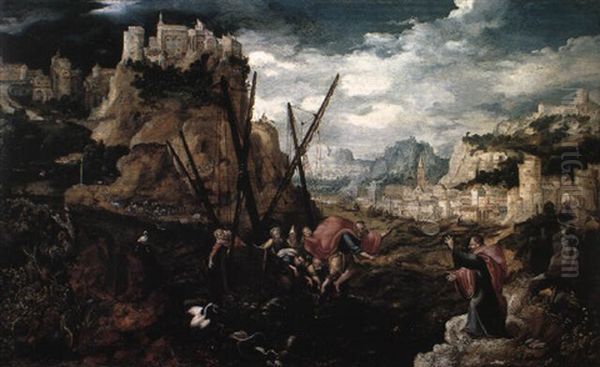
The most significant influence was undoubtedly Joachim Patinir. Bles adopted Patinir's high viewpoint, panoramic scope, and basic compositional structure, becoming the leading exponent of this style after Patinir's death. He expanded upon Patinir's repertoire, however, often incorporating more dynamic compositions and a wider range of subjects.
The fantastical imagery of Hieronymus Bosch also left a discernible mark, particularly in Bles's depictions of hellish scenes or temptations populated by grotesque demons. Bles translated Bosch's nightmarish visions into his own landscape framework.
As mentioned, the theoretical work of Leonardo da Vinci on atmospheric perspective seems to have informed Bles's subtle rendering of distance through colour and haze.
Within his own workshop in Antwerp, Bles likely collaborated with assistants. Frans Mostaert is documented as having been his pupil, suggesting a direct transmission of style and technique. The existence of numerous workshop versions of popular compositions points to a collaborative studio practice.
Interestingly, some scholarship suggests later interactions with Bles's work. For instance, analysis of a Holy Family with the Infant Saint John the Baptist attributed to Bles indicates possible later additions or overpainting by the workshop of the much later Flemish master, Peter Paul Rubens, demonstrating the enduring appeal and adaptability of Bles's compositions.
Bles's own influence extended to subsequent generations of landscape painters. His innovative approach to composition, particularly his use of dramatic rock formations and diagonal sightlines, paved the way for artists like Pieter Bruegel the Elder. Bruegel, while developing a profoundly original vision, clearly learned from Bles's panoramic constructions and integration of genre elements into landscape. Bles's impact can also be seen in the work of other landscape specialists active around the same time or slightly later, such as Lucas van Valckenborch and Marten van Valckenborch. His style resonated particularly with artists interested in depicting mountainous or rocky terrain. The influence of artists like Hans Holbein has also been noted in relation to specific works, suggesting a broader awareness of contemporary artistic currents.
Legacy and Art Historical Significance
Despite the uncertainties surrounding his life and the fact that he may not have achieved widespread fame during his lifetime compared to some contemporaries, Herri met de Bles holds a crucial position in the history of art. His primary contribution lies in the development and popularization of landscape painting as a genre capable of conveying complex narratives and profound emotions.
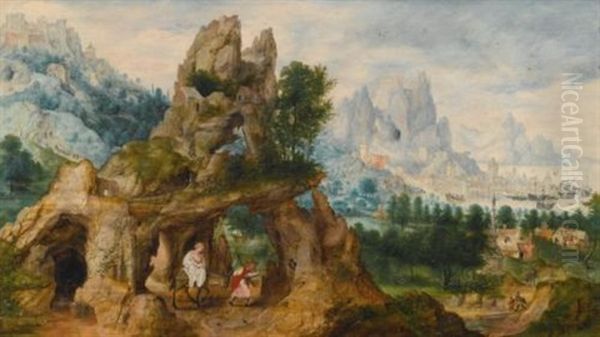
He successfully built upon the foundations laid by Patinir, infusing the "World Landscape" with greater dynamism, more varied subject matter, and a distinctive personal style marked by his signature rock formations and atmospheric effects. His willingness to incorporate detailed scenes of secular life, particularly industry, alongside traditional religious themes broadened the scope of landscape art.
His work served as a vital link between the early experiments of Patinir and the mature landscape and genre paintings of Pieter Bruegel the Elder and his followers. Bruegel, in particular, absorbed lessons from Bles's compositional strategies and his ability to imbue landscapes with meaning and narrative weight.
Today, Herri met de Bles is recognized as a key innovator of the Northern Renaissance. His paintings are studied for their unique blend of observation and fantasy, their technical skill, and their role in establishing landscape as a major genre in Western art. While the man remains partly shrouded in mystery, his artistic legacy is clear: evocative landscapes that continue to intrigue viewers with their intricate details and imaginative scope.
Challenges in Studying Bles
The study of Herri met de Bles is complicated by several factors inherent in the art production and documentation practices of the 16th century. A significant number of works associated with him are unsigned and undated, making definitive attribution and chronological sequencing difficult. The presence of a workshop further complicates matters, as distinguishing between the master's hand, assistants' contributions, and outright copies or imitations requires careful connoisseurship and technical analysis.
Furthermore, the biographical details remain frustratingly sparse. The confusion over his exact dates, birthplace, and even the precise nature of his relationship with Patinier highlights the limitations of surviving historical records for many artists of this period. The anecdotal nature of some information, like the story of his death in Ferrara or the exact meaning of the owl motif, adds colour but lacks firm documentary proof. These challenges mean that our understanding of Bles is continually refined through ongoing scholarly research and analysis of his distinctive visual language.
Conclusion: A Visionary Landscapist
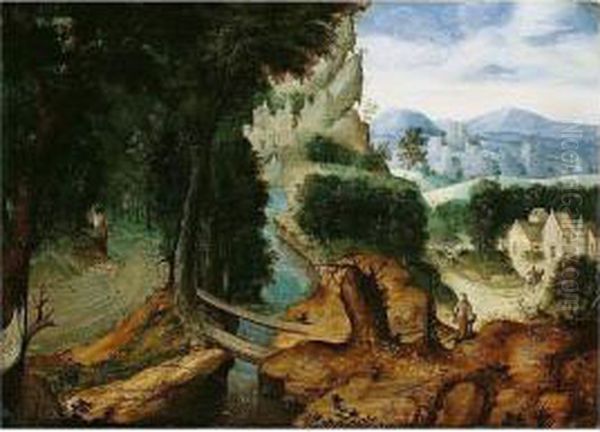
Herri met de Bles emerges from the historical haze as a pivotal figure in 16th-century Flemish painting. As a leading practitioner of the "World Landscape," he crafted expansive, imaginative vistas that captivated audiences both north and south of the Alps. His unique style, characterized by dramatic rock formations, atmospheric depth, and the skillful integration of narrative detail, marked a significant evolution in the landscape genre. Though biographical details remain elusive, his artistic influence, particularly on the trajectory leading to Pieter Bruegel the Elder, is undeniable. Herri met de Bles secured his place in art history as an innovative painter who elevated the landscape from mere background to a powerful expressive force.